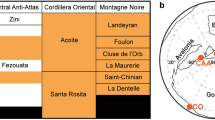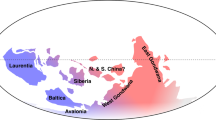Abstract
Origins of the present day distribution of several freshwater and marine phyletic groups of ostracods are described using both Recent and fossil data. Six examples of subterranean ostracods distributed world-wide are discussed. The first two examples (i.e. the Candoninae Namibcypridini and the Sphaeromicolinae) seemed, in a first approach, to fit well with the ‘vicariance model’ but a detailed study demonstrate that their present day distribution can not be seen as a consequence of any geological events. The four other examples (the Xestoleberis arcturi species group, the Tuberoloxoconcha, the Cavernocypris and Fabaeformiscandona wegelini) fit well with the ‘dispersionist model’. We propose a biogeographical model similar to the dispersal one which foccus on the ecological processes occurring at local and/or regional scales. Some present day species or their epigean ancestors may originally have been more widely dispersed. These species were predisposed to colonize subsurface habitats; a process that could occur polytopically and at various times. It is the degree of ecological flexibility, the width of ecological tolerance, the type of preadaptations, and the capacity to perceive and successfully invade new environments that allow subsurface ostracods to migrate actively or be dispersed passively through both subterranean and epigean aquatic systems and to settle in new places. But no centers of origin and direction of dispersal can be identified in our data. There is little known about the autecology of subterranean ostracod taxa with broad geographical ranges. Samples should be collected at fine (habitat) and broad scales (regional surveys) so that we can better understand the modes of ostracod dispersal across a range of spatial scales.
Similar content being viewed by others
References
Banarescu, P., 1990. Zoogeography of fresh waters. Vol. 1. Aula, Wiesbaden, 511 pp.
Boulton, A. J., S. E. Stibbe, N. B. Grimm & S. G. Fisher, 1991. Invertebrate recolonisation of small patches of defaunated hyporheic sediments in a Sonoran desert stream. Freshwat. Biol. 26: 267–277.
Boulton, A. J., H. M. Valett & S. G. Fisher, 1992. Spatial distribution and taxonomic composition of the hyporheos of several Sonoran Desert streams. Arch. Hydrobiol. 125: 37–61.
Broodbakker, N., 1983. The subfamily Candoninae (Crustacea, Ostracoda) in the West indies. Bijdr. Dierk. 53: 287–326.
Broodbakker, N., 1984. The distribution and zoogeography of freshwater Ostracoda in the West Indies. Bijdr. Dierk. 54: 25–50.
Craw, R. & R. Page, 1988. Panbiogeography: method and metaphor in the new biogeography. In H. W. Ho and S. W. Fox (eds.), Evolutionary Processes and Metaphors. Wiley & Sons, Chichester: 163–190.
Christiansen, K. & D. C. Culver, 1987. Biogeography and the distribution of cave Collembola. J. Biogeogr. 14: 459–477.
Christie, D. M., R. A. Duncan, A. R. Mc Birney, M. A. Richards, W. M. White, K. S. Harp & C. G. Fox, 1992. Drowned islands downstream from the Galapagos hotspot imply extended speciation times. Nature 355: 246–248.
Croizat, L, 1978. Deduction, induction and biogeography. Syst. Zool. 27: 209–213.
Danielopol, D. L., 1977. Recherches sur les Ostracodes Entocytheridae. Données sur Sphaeromicola cebennica juberthiei nov. ssp. et Sphaeromicola cirolanae Rioja. Int. J. Speleol. 9: 21–41.
Danielopol, D. L., 1980. An essay to assess the age of the freshwater interstitial ostracods of Europe. Bijdr. Dierk. 50: 243–291.
Danielopol, D. L., 1983. Der Einfluss organischer Verschmutzung auf das Grundwasser-Ökosystem der Donau im Raum Wien und Niederösterreich. Forschungsberichte BMGU 5: 5–159.
Danielopol, D. L., 1991. Spatial distribution and dispersal of interstitial Crustacea in alluvial sediments of a backwater of the Danube at Vienna. Stygologia 6: 97–110.
Danielopol, D. L. & G. Bonaduce, 1990a. The colonisation of subsurface habitats by the Loxoconchidae Sars and the Psammocytheridae Klie. In R. Whatley & C. Maybury (eds), Ostracoda and Global Events. Chapman & Hall, London: 437–458.
Danielopol, D. L. & G. Bonaduce, 1990b. Origin and distribution of the interstitial species group Xestoleberis arcturi Triebel (Ostracoda, Crustacea). Cour. Forsch. -Inst. Senckenberg 123: 69–86.
Danielopol, D. L. & C. W. Hart, 1985. Notes on the center of origin and the antiquity of the Sphaeromicolinae, with description of Hobbsiella, new genus (Ostracoda, Entocytheridae). Stygologia 1: 54–70.
Danielopol, D. L. & G. Hartmann, 1986. Ostracoda. In L. Botosaneanu (ed.), Stygofauna Mundi. E. S. Brill, Leiden: 259–294.
Danielopol, D. L., W. E. Piller & T. Huber, 1991. Pseudolimnocythere hainburgensis n. sp. (Ostracoda, Loxoconchidae) aus Wiener Beckens. N. Jb. Geol. Paläont. Mh. 8: 458–469.
Danielopol, D. L. & R. Rouch, 1991. L'adaptation des organismes au milieu aquatique souterrain. Réflexions sur l'apport des recherches écologiques récentes. Stygologia 6: 129–142.
Danielopol, D. L. & K. Wouters, 1992. Evolutionary (Paleo)biology of marine interstitial ostracods. Geobios 25: 207–211.
Darlington, P. J., 1957. Zoogeography: the geographical distribution of animals. Wiley & Sons, New York, 675 pp.
Forester, R. M., 1991. Ostracode assemblages from springs in the western United States: implication for paleophydrology. Mem. ent. Soc. Can. 155: 181–201.
Grimm, N. B. & S. G. Fischer, 1989. Stability of periphyton and macroinvertebrates to disturbance by flash floods in a desert stream. J. N. Am. Benthol. Soc. 8: 293–307.
Hart, C. W., 1978. A new species of the genus Sphaeromicola (Ostracoda, Entocytheridae, Sphaeromicolinae) from Texas, with notes on relationships between European and North American species. Proc. biol. Soc. Wash. 91: 724–730.
Hagerman, G. H. & R. M. Rieger, 1981. Dispersal of benthic meiofauna by wave and current action in Bogne Sound, North Carolina, USA. P. S. Z. N. I. Mar. Ecol. 2: 245–270.
Hobbs, H. H., Jr., 1971. The enthocytherid ostracods of Mexico and Cuba. Smithson. Contr. Zool. 81: 1–55.
Holsinger, J. & G. Longley, 1980. The subterranean amphipod crustacean fauna of an artesian well in Texas. Smithson. Contr. Zool. 308: 1–162.
Horne, D., 1989. On Tuberoloxoconcha atlantica sp. nov. Stereo-atlas Ostracod Shells 16: 73–76.
Humphries, C. J. & L. R. Parenti, 1986. Cladistic biogeography. Clarendon Press, London, 98 pp.
Hsu, K. J., 1978. When the Black Sea was drained. Scien. Am. 238: 53–62.
Jokiel, P. L., 1990. Long-distance dispersal by rafting: reemergence of an old hypothesis. Endeavour 14: 66–73.
Kern, J. C. & G. L. Taghon, 1986. Can passive recruitment explain harpacticoid copepod distributions in relation to epibenthic structure? J. exp. mar. Biol. Ecol. 101: 1–23.
Lattin, G., 1967. Grundriss der Zoogeographie. G. Fischer, Jena, 602 pp.
Loffler, H. & J. Leibetseder, 1965. Daten zur Dauer des Darmdurchganges bei Vögeln. Zool. Anz. 177: 334–340.
Maddocks, R. F., 1982. Ostracoda. In L. G. Abele (ed.), The Biology of Crustacea, Vol. 1: Systematics, the fossil Record and Biogeography. Academic Press, New York: 221–239.
Maddocks, R. F. & T. M. Illife, 1991. Anchialine podocopid Ostracoda of Galapagos Islands. Zool. J. Linn. Soc. 103: 75–99.
Marmonier, P., 1985. Répartition spatiale des Ostracodes dans les sédiments d'un ruisseau alpin (le Seebach à Lunz, Autriche). Verh. int. Verein. Limnol. 22: 2053–2057.
Marmonier, P., 1988. Biocénoses interstitielles et circulation des eaux dans le sous-écoulement d'un chenal aménagé du Haut Rhône français. Th. Doct. Univ. Lyon 1, 2 vol.: 1–161, 1–108.
Marmonier, P., 1991. Effect of alluvial shift on the spatial distribution of interstitial fauna. Verh. int. Verein. Limnol. 24: 1613–1616.
Marmonier, P. & M. Creuzé des Châtelliers, 1992. Biogeography of the benthic and interstitial living ostracods (Crustacea) of the Rhône River (France). J. Biogeogr. 19: 694–704.
Marmonier, P., C. Meisch, & D. L. Danielopol, 1989. A review of the genus Cavernocypris Hartmann (Ostracoda, Cypridopsinae): systematics, ecology and biogeography. Bull. Soc. Nat. Luxemb. 89: 221–278.
Marmonier, P. & J. V. Ward, 1990. Superficial and interstitial ostracods of the South Platte River (Colorado, USA). Systematics and biogeography. Stygologia 5: 225–239.
Martens, K., 1992. On Namibcypris costata n. gen. n. sp. (Crustacea, Ostracoda, Candoninae) from a spring in northern Namibia, with the description of a new tribe and a discussion on the classification of the Podocopina. Stygologia 7: 27–42.
McKenzie, K. G., 1991. Implications of shallow Tethys and the origin of modern oceans. Aust. Syst. Bot. 4: 37–40.
Myers, A., 1988. Endemism in Hawaiian marine invertebrates. TREE 3: 20–21.
Palmer, M. A., 1988. Dispersal of marine meiofauna: a review and conceptual model explaining passive transport and active emergence with implications for recruitment. Mar. Ecol. Prog. Ser. 48: 81–91.
Palmer, M. A., 1990. Understanding the movement dynamics of a stream dwelling meiofauna community using marine analogs. Stygologia 5: 67–74.
Palmer, M. A., 1992. Incorporating lotic meiofauna into our understanding of faunal transport processes. Limnol. Oceanogr. 37: 329–341.
Palmer, M. A., A. E. Bely & K. E. Berg, 1992. Response of invertebrates to lotic disturbance: a test of the hyporheic refuge hypothesis. Oecologia 89: 182–194.
Reyment, R., 1983. West african and north american transgressional maxima and the dispersal of benthic organisms. J. Afr. Earth. Sci. 1: 255–262.
Roca, J. & D. L. Danielopol, 1991. Exploration of interstitial habitats by the phytophilous ostracod Cypridopsis vidua (O. F. Müller): experimental evidence. Annls. Limnol. 27: 243–252.
Rogulj, B., P. Marmonier, R. Lattinger & D. L. Danielopol, 1994. Fine-scale distribution of hypogean Ostracoda in the interstitial habitats of the Rivers Sava and Rhône. Hydrobiologia 287: 19–28.
Rosen, D. E., 1978. Vicariant patterns and historical explanation in biogeography. Syst. Zool. 27: 159–188.
Schram, F. R., 1986. Crustacea. Oxford Univ. Press, New York, 606 pp.
Sohn, I. G. & L. S. Kornicker, 1979. Viability of freeze-dried eggs of the freshwater Heterocypris incongruens. In N. Kristic (ed.), Taxonomy, Biogeography and Distribution of Ostracodes. Serbian Geol. Soc. Belgrade: 1–4.
Stock, J. H., 1980. Regression model evolution as exemplified by the genus Pseudoniphargus (Amphipoda). Bijdr. Dierk. 50: 105–144.
Stock, J. H., 1990. Insular groundwater biotas in the (sub)tropical Atlantic: a biogeographic synthesis. Atti Convegni Acad. do Lincei 85: 695–713.
Tilzer, M., 1973. Zum problem der Ausbreitungsfähigkeit von limnisch-interstitiellen Grundwassertieren am Beispiel von Troglochaetus beranecki Delacheaux (Polychaeta, Arachianelida). Arch. Hydrobiol. 72: 263–269.
Vallet, H. M., S. G. Fisher & E. H. Stanley, 1990. Physical and chemical characteristics of the hyporheic zone of a Sonoran desert stream. J. N. Am. Benthol. Soc. 9: 201–215.
Weissleader, L. S., N. L. Gilinsky, R. M. Ross & T. M. Cronin, 1989. Biogeography of marine podocopid ostracodes in Micronesia. J. Biogeogr. 16: 103–114.
Westheide, W., 1991. The meiofauna of the Galapagos. In M. J. James (ed.), Galapagos Marine Invertebrates. Taxonomy, biogeography and evolution in Darwin's Islands. Plenum Press, New York: 37–73.
Witte, L. & D. Van Harten, 1991. Polymorphism, biogeography and systematics of Kotoracythere inconspicua (Brady, 1980) (Ostracoda: Pectocytheridae). J. Biogeogr. 18: 427–436.
Author information
Authors and Affiliations
Additional information
U.A. CNRS N° 1451 ‘Ecologie des Eaux Douces et des Grands Fleuves’
Rights and permissions
About this article
Cite this article
Danielopol, D.L., Marmonier, P., Boulton, A.J. et al. World subterranean ostracod biogeography: dispersal or vicariance. Hydrobiologia 287, 119–129 (1994). https://doi.org/10.1007/BF00006901
Issue Date:
DOI: https://doi.org/10.1007/BF00006901




